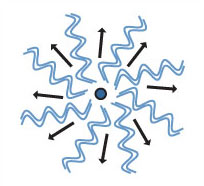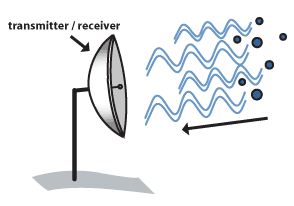When the electromagnetic pulse encounters a target (image a), the pulse is scattered in all directions (image b). The signal received is much weaker than the original sent from the transmitter. This is called the return signal (image c). Several factors affect how strong the return signal is. The larger the target, the stronger the return signal. For example, if a radar pulse encounters a large piece of hail, it will send back a stronger signal than if it struck a small raindrop. Also, the more targets there are to scatter the pulse, the stronger the return will be. That's because the return signals from each target combine to produce a stronger signal. This means that many raindrops will produce a stronger return than a few raindrops. |  | |
(a) Radar encountering a target.
|
 | |
(b) Target scattering radar.
|
|









